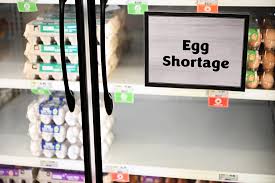In 2025, the global egg industry faces a significant crisis. A combination of factors, including a severe avian influenza outbreak, supply chain disruptions, and market dynamics, has led to widespread egg shortages and soaring prices. Consumers and businesses alike are grappling with the implications of this shortage, which has disrupted traditional practices and prompted calls for systemic changes in the poultry industry.
🐔 Causes of the Egg Shortage
1. Avian Influenza (Bird Flu) Outbreak
The primary driver of the 2025 egg shortage is the outbreak of highly pathogenic avian influenza (HPAI), specifically the H5N1 strain. This virus has led to the culling of millions of egg-laying hens to prevent its spread. The loss of these birds has significantly reduced egg production capacity, leading to supply shortages.
2. Supply Chain Disruptions
Beyond the immediate impact of the avian flu, the egg industry has faced broader supply chain challenges. Labor shortages, transportation issues, and increased feed costs have compounded the problem, making it difficult for producers to meet demand.
3. Market Dynamics and Corporate Practices
Some reports suggest that major egg producers may be capitalizing on the crisis to increase profits. The highly concentrated nature of the egg market allows a few corporations to exert significant control over pricing, potentially exacerbating the situation for consumers.
📈 Impact on Prices and Consumers
The egg shortage has led to unprecedented price increases. In some areas, the cost of a dozen eggs has reached record highs, with prices doubling or even tripling compared to previous years. This surge has placed a financial strain on households and businesses, particularly those in the food service industry.
Consumers have reported empty shelves in grocery stores, and some retailers have implemented purchase limits to manage the shortage. Traditional practices, such as Easter egg hunts, have been affected, with some families turning to alternatives like decorating potatoes.
🛡️ Government and Industry Responses
1. USDA Initiatives
In response to the crisis, the U.S. Department of Agriculture (USDA) has announced a comprehensive strategy to combat avian flu and stabilize the egg market. This includes a $1 billion investment in biosecurity measures, research into vaccines, and support for affected farmers.
2. Exploration of Vaccination
The USDA is also considering the vaccination of poultry against avian flu as a long-term solution. While this approach presents challenges, such as potential trade restrictions, it could play a crucial role in preventing future outbreaks.
🔮 Outlook and Recommendations
Experts predict that the egg supply may not normalize until mid-2025, with price volatility expected to continue in the short term. To mitigate the impact of future crises, stakeholders recommend:
- Diversifying supply chains to reduce dependence on large-scale producers.
- Investing in biosecurity and disease prevention measures.
- Encouraging transparency and competition within the egg industry to prevent price manipulation.
Sources:
U.S. Department of Agriculture (USDA) Press Releases:
- USDA Invests Up To $1 Billion to Combat Avian Flu and Reduce Egg Prices
https://www.usda.gov/about-usda/news/press-releases/2025/02/26/usda-invests-1-billion-combat-avian-flu-and-reduce-egg-prices - USDA Update on Progress of Five-Pronged Strategy to Combat Avian Flu and Lower Egg Prices
https://www.usda.gov/about-usda/news/press-releases/2025/03/20/usda-update-progress-five-pronged-strategy-combat-avian-flu-and-lower-egg-prices
News Articles and Reports:
- Egg Prices Fall for First Time in Nearly a Year, Report Says – Investopedia
https://www.investopedia.com/egg-prices-fall-for-first-time-in-nearly-a-year-earnest-analytics-says-11715513 - Egg Prices Predicted to Soar More Than 41% in 2025: USDA – ABC News
https://abcnews.go.com/Business/egg-prices-predicted-rise-411-2025-usda/story?id=119182317 - Egg Prices Could Rise by 41.1% This Year, USDA Estimates – Axios
https://www.axios.com/2025/02/26/bird-flu-egg-prices-growing-shortages-eggs - Egg Prices Are Skyrocketing—But Why Are Some Cage-Free Ones Cheaper Than Regular? – SELF
https://www.self.com/story/egg-prices-bird-flu-2025 - Egg Shortage Hits Consumers Hard – The Famuan
https://www.thefamuanonline.com/2025/02/16/egg-shortage-hits-consumers-hard/ - Egg Shortage Hits Local Restaurants and Consumers – The Charlotte Post
https://www.thecharlottepost.com/news/2025/03/19/business/egg-shortage-hits-local-restaurants-and-consumers/ - Waffle House Implements 50 Cent Surcharge on Each Egg Due to Supply Issues Caused by Bird Flu – People
https://people.com/waffle-house-egg-surcharge-due-to-supply-issues-caused-by-bird-flu-8786100 - Egg Prices Could Jump 41% This Year, USDA Says, as Trump’s Bird Flu Plan Unveiled – AP News
https://apnews.com/article/record-egg-prices-usda-bird-flu-virus-92e9f5fbc4e0a792be484a4aee5b9c16 - Egg Prices Predicted to Rise 41.1% in 2025 Amid Avian Flu Outbreak – Telemundo CC
https://www.telemundocc.com/health/bird-flu/usda-forecasts-egg-prices-to-surge-41-in-2025-amid-avian-flu-outbreak - Egg Prices Could Rise by 41.1% This Year, USDA Estimates – Axios
https://www.axios.com/2025/02/26/bird-flu-egg-prices-growing-shortages-eggs
USDA Reports:
- Egg Markets Overview – April 18, 2025 – USDA
https://www.ams.usda.gov/mnreports/ams_3725.pdf



